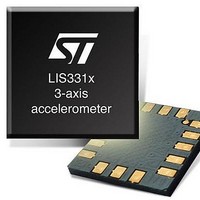LIS3LV02DL STMicroelectronics, LIS3LV02DL Datasheet - Page 24

LIS3LV02DL
Manufacturer Part Number
LIS3LV02DL
Description
Board Mount Accelerometers MEMS INERTIAL SENSOR
Manufacturer
STMicroelectronics
Datasheet
1.LIS3LV02DL.pdf
(48 pages)
Specifications of LIS3LV02DL
Sensing Axis
X, Y, Z
Acceleration
2 g, 6 g
Digital Output - Number Of Bits
12 bit, 16 bit
Supply Voltage (max)
3.6 V
Supply Voltage (min)
2.16 V
Supply Current
0.65 mA
Maximum Operating Temperature
+ 85 C
Minimum Operating Temperature
- 40 C
Digital Output - Bus Interface
I2C, SPI
Sensitivity
1024 LSB/g
Package / Case
LGA-16
Output Type
Digital
Acceleration Range
±2g, ±6g
No. Of Axes
3
Interface Type
I2C, SPI
Sensitivity Per Axis
1024LSB / G
Sensor Case Style
LGA
No. Of Pins
16
Supply Voltage Range
2.16V To 3.6V
Rohs Compliant
Yes
Lead Free Status / RoHS Status
Lead free / RoHS Compliant
Available stocks
Company
Part Number
Manufacturer
Quantity
Price
Part Number:
LIS3LV02DL
Manufacturer:
ST
Quantity:
20 000
Digital interfaces
5.2
24/48
Data are transmitted in byte format (DATA). Each data transfer contains 8 bits. The number
of bytes transferred per transfer is unlimited. DATA is transferred with the Most Significant bit
(MSb) first. If a receiver can’t receive another complete byte of data until it has performed
some other function, it can hold the clock line, SCL LOW to force the transmitter into a wait
state. Data transfer only continues when the receiver is ready for another byte and releases
the data line. If a slave receiver doesn’t acknowledge the slave address (i.e. it is not able to
receive because it is performing some real time function) the data line must be left HIGH by
the slave. The Master can then abort the transfer. A LOW to HIGH transition on the SDA line
while the SCL line is HIGH is defined as a STOP condition. Each data transfer must be
terminated by the generation of a STOP (SP) condition.
In order to read multiple bytes, it is necessary to assert the most significant bit of the sub-
address field. In other words, SUB(7) must be equal to ‘1’ while SUB(6-0) represents the
address of first register to read.
In the presented communication format MAK is Master Acknowledge and NMAK is No
Master Acknowledge.
SPI bus interface
The LIS3LV02DL SPI is a bus slave. The SPI allows to write and read the registers of the
device.
The serial interface interacts with the outside world with 4 wires: CS, SPC, SDI and SDO.
Figure 6.
CS is the Serial Port Enable and it is controlled by the SPI master. It goes low at the start of
the transmission and goes back high at the end.
SPC is the Serial Port Clock and it is controlled by the SPI master. It is stopped high when
CS is high (no transmission).
SDI and SDO are respectively the Serial Port Data Input and Output. Those lines are driven
at the falling edge of SPC and should be captured at the rising edge of SPC.
Both the Read Register and Write Register commands are completed in 16 clock pulses or
in multiple of 8 in case of multiple byte read/write. Bit duration is the time between two falling
edges of SPC. The first bit (bit 0) starts at the first falling edge of SPC after the falling edge
of CS while the last bit (bit 15, bit 23, ...) starts at the last falling edge of SPC just before the
rising edge of CS.
SDO
SPC
SDI
CS
Read and write protocol
RW
MS
AD5 AD4 AD3 AD2 AD1 AD0
DO7 DO6 DO5 DO4 DO3 DO2 DO1 DO0
DI7 DI6 DI5 DI4 DI3 DI2 DI1 DI0
LIS3LV02DL













